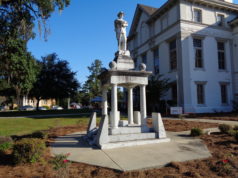A couple of weeks ago, the Weekly printed a letter from Jim Bryant taking me to task for dissing the decision by the National Center for Atmospheric Research (NCAR) to locate its new $500 million supercomputer in Cheyenne, Wyo. — where it can get cheap, coalgenerated electricity — without suggesting alternatives.
Fair enough.
Here are some alternatives that NCAR could pursue for powering its computer — regardless of where it chose to put the thing:
1. Put enough solar cells on the roof of the computing center to generate all the power it needs. If the roof isn’t big enough, put additional cells in the field next to it. In order to get enough power for 24/7 computing, generate twice as much power as is needed during the day, sell the surplus to the local electric company, and buy it back at night.
2. Use the same strategy, only with wind turbines.
3. Invest in a solar thermal power plant in the Mojave Desert and — using the miracle of hightension power lines — bring enough electricity from it to run the computing center. Such plants can be equipped with tanks of hot oil or molten salt to store heat collected during the day to run the plant at night.
4. Invest in a nuclear power plant and bring the power to the computer center. Or just buy the power from an existing nuke.
5. Instead of putting up its own solar cells or wind turbines, NCAR could do what a lot of homeowners and businesses do — pay Xcel Energy (or whoever their electric utility turns out to be) a premium for wind power or non-fossil-fuel-generated electricity. Xcel will then put up additional wind- or solar-generating capacity sufficient to cover NCAR’s use.
6. Cut a deal with the Denver Water Board to install turbines at one of its reservoirs with sufficient generating capacity to supply the computing center with the needed power.
7. Move the computing center to Greeley instead of Cheyenne, and cut a deal with a feedlot to generate electricity from methane gas derived from cowshit.
8. Power the new supercomputer with coal-generated electricity and purchase carbon offsets.
9. Take the soft path. Instead of building a 100,000-processor supercomputer at a cost of $500 million, do what the folks searching for extraterrestrial life have done. Write software allowing private citizens to network their personal computers into a giant computing network that does the processing when the machines aren’t being otherwise used. This might not do much to reduce NCAR’s carbon footprint — although it might be possible to write the software to give priority to machines in areas where green
electricity is available — but it could save NCAR a bundle on its
utility bill, because the volunteers would end up paying for the
electricity.
All
of these technologies are available off-the-shelf today. And the urgent
adoption of all of them is being widely touted as necessary to cut the
world’s output of greenhouse gases to the point where global
temperatures will rise no more than 2 degrees Celsius by the end of the
century — damn the economic and social consequences. Senior climate
scientists at NCAR are among those most insistent on this point.
Of
course, all of these technologies (with the possible exception of the
last one) would produce electricity that costs more than powering the
computer center with el cheapo Wyoming coal-generated electricity —
which is NCAR’s stated reason for locating the computer center in
Cheyenne (they don’t emphasize the coal part).
The
cost of electricity is evidently not just the main thing for NCAR; it’s
the only thing. If the institute located its computing center in
Boulder, it would still be computing with fossil fuel-generated
electricity, supplied by Xcel, but Xcel power costs more than power
generated in Wyoming (probably because Xcel has more natural gas in its
fuel mix and because it has to haul in the coal it uses from out of
state.) But the cost difference between Wyoming and Colorado fossil
fuel-generated electricity is enough for NCAR to choose Wyoming. The
thought of using non-fossil-fuel-generated electricity apparently
didn’t enter into the decision.
Personally,
I don’t give a rip whether NCAR chooses to locate its computing center
in Boulder, Cheyenne, or Tierra del Fuego (where it could build a
geothermal power plant, come to think of it).
But
I submit that its decision to opt for coal power rather than any of the
assorted green technologies makes a mockery out of the warnings from
NCAR scientists about the dangers of global warming and the urgency of
doing anything about it.
It also makes the lords of Table Mesa laughing stocks in the eyes of the Second and Third Worlds — and large parts of the First.














